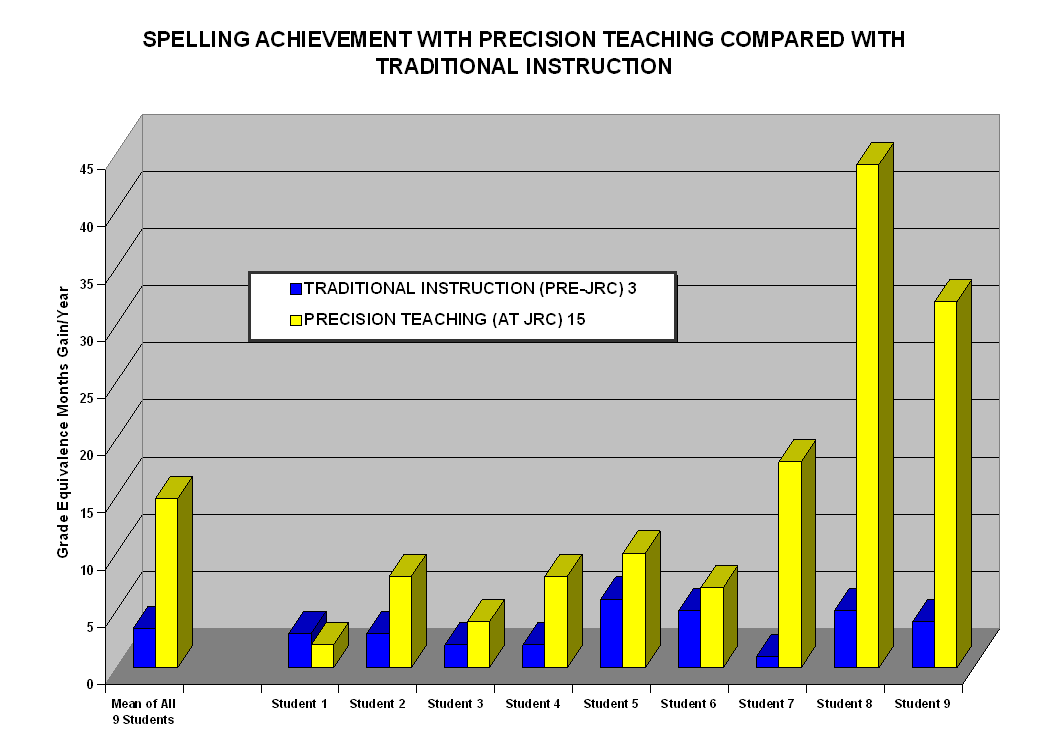
|
Use of Skin-Shock at the Judge Rotenberg Educational Center (JRC) |
Improved Standard Scores in Spelling Utilizing Precision Teaching with Computer Self-Instruction Software and Reward Systems
Michelle O’Neall Harrington, Timothy J. Paisey, Matthew L. Israel Ph.D., Edward G. Langford, Jr., & Erin E. Holland
The Judge Rotenberg Educational Center (www.judgerc.org) operates day and residential programs for children and adults with behavior problems, including conduct disorders, emotional problems, brain injury or psychosis, autism, and developmental disabilities. The fundamental approach taken at JRC is the use of behavioral psychology and its various technological applications, including behavioral education, programmed instruction, precision teaching, behavior modification, behavior therapy, behavioral counseling, self-management of behavior, and chart-sharing.
The majority of students referred to JRC display complex profiles of surplus and deficit behaviors that include significant delays in basic academic skills. Instruction in academic behaviors at JRC employs principles of Precision Teaching (PT) (Potts, Eshleman & Cooper, 1993) emphasizing fluency building or “overlearning” (Binder, 1987) to promote retention and automatic, error-free application. The current study reports spelling improvement for 9 adolescents who had significant delays in spelling and who received PT instruction with programmed reward to improve their spelling fluency. The inductive methods of PT are concerned with demonstrating measurably effective instruction. The current sample of opportunity allows a comparison of summary academic achievement scores following uncontrolled exposure to traditional Special Education services versus PT within a behaviorally engineered setting.
METHOD
Participants and Setting
An opportunity sample of 9 students enrolled at JRC was selected based on consistently identified need for improvement in Spelling identified in their Individual Educational Plans (IEPs). The four female and five male students had a mean age of 15 yr, 5 mo (range 12 yr, 5 mo – 20 yr, 1 mo), a mean Verbal IQ of 75 (range 59 – 99), and a mean Spelling Grade Equivalence (G.E.) of 2-2 (range 1-0 – 4-5) at the time of admission (see Figure 1). Students had diagnostic labels that included learning disorders, disruptive behavior disorders, mood disorders, anxiety disorders, pervasive developmental disorders, organic brain syndrome and mental retardation. They lived in JRC’s community residences and attended educational classes at JRC’s school building.
Measures and Instruction
Kaufman Test of Educational Achievement – Comprehensive Form (K-TEA) Spelling scores were initially obtained for students at admission and following participation in the PT curriculum. Spelling scores were expressed as Grade Equivalence.
During PT participants completed assigned spelling lessons from JRC’s Spelling Curriculum. Lessons were organized into six levels, each based on G.E. Each level contained five chapters each comprised of eight individual lessons, three of which were review lessons. Students were required to complete each lesson at a rate of 20 correct per minute (“aim”), using the hear/type learning channel. Instructional stimuli were recorded as audio files for administration via JRC’s Practice Mill PT software. This provided shuffled stimuli, as well as hints and error correction. For incorrect responses, the correct spelling was shown on the screen. In addition, the word was repeated up to 15 successive times, or until it was spelled correctly. Students practiced at their own pace until meeting their aim for a lesson.
Students were assigned computerized lessons from the levels that coincided with their current Spelling G.E. The mastery criterion of 20 correct words/min for passing each lesson was assessed using a two-line learning picture (see Figure 1). Upon meeting criterion, students were immediately rewarded. The reinforcer that was used was the opportunity to play one of four video games which automatically appeared on the screen for two minutes. The students did not have a choice of which video game with which they were rewarded upon attaining mastery. All timings were overseen by the classroom teacher and curriculum developer. Students were automatically moved on from lesson to lesson, but had to be manually moved from one level to the next.
RESULTS
Participants in the study were referred for behaviorally-engineered education following an extensive history of low academic achievement. Their mean Spelling G.E. at admission to JRC of 2-2 was very significantly delayed relative to age expectations and reflected an average prior rate of improvement of 3 mo G.E. per academic year across their previous schooling. The average improvement for all 9 participants in JRC’s behaviorally engineered educational program was 15 months/year. 8 of the 9 participants improved their spelling skills at a substantially faster rate than previously attained (average 15 months G.E. versus 3 months G.E. improvement per academic year). Two participants achieved increases in K-TEA Spelling of 8 G.E. or more. There was an apparent relationship between Verbal IQ and the rate of improvement in Spelling, suggesting that both measures might sample the same behavior category. (A comparison of KTEA scores for each student upon admission to JRC and after participation in JRC’s Precision Teaching curriculum can be found in Figure 2.)
DISCUSSION
PT with programmed reward represents a demonstrably effective intervention for students with histories of significant academic delays. Consistent increases in rate of acquiring spelling fluency were observed during PT within a structured behavioral program relative to previous Special Education interventions irrespective of students’ general cognitive ability. Although an uncontrolled A-B trial, these indications of differential effectiveness of PT with programmed reward are of sufficient magnitude to warrant more widespread application.
REFERENCES
Binder, C. V., (1987). Fluency-building. Precision Teaching and Management Systems, Inc.
Potts, L., Eshleman, J. W., & Cooper, J. O., (1993). Ogden R. Lindsley and the historical development of Precision Teaching, The Behavior Analyst, 16, 177-189.
